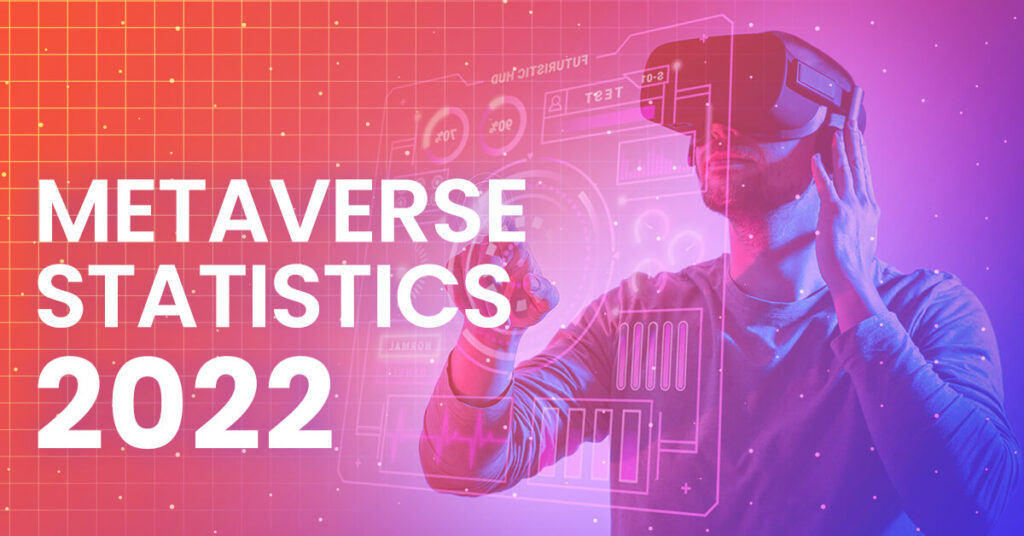If you’re interested in the Metaverse and how it may impact our future, the following metaverse statistics will give you a good idea of how big the Metaverse is, who is using it, and how the Metaverse industry may benefit your business.
The world is changing faster and more profoundly than ever before. We’ve entered an age of transformation many have referred to as the fourth industrial revolution or the digital transformation. As a result, many new innovations are being discussed and adopted around the world as we begin to see a future where digital technology is a ubiquitous part of everyday life for everyone.
What this means for the life sciences brands is that in order to remain competitive, they must adapt to these new technological trends and find ways to leverage them to improve the customer experience, increase the speed of their service offerings, and ultimately, drive sales.
For example, consider the recent developments in digital health. In 2016, the Food and Drug Administration (FDA) approved the use of digital technology to monitor patients with diabetes.
The use of this technology is meant to reduce the number of potential errors associated with finger-prick blood glucose monitoring tests and increase patient safety. Nowadays, virtually every doctor who prescribes medication for patients with diabetes uses systems that are connected to a patient’s smartphone or tablet. These systems can automatically send reminders for patients to take their medicine and provide real-time feedback regarding their blood glucose levels.
This is just a glimpse of how digital evolution is already benefiting brands in the life science sector. Prepare to be amazed as you learn more about the Metaverse and the way experts predict that it will impact businesses, healthcare, and daily life.
Metaverse 101: Time To Get Serious
Before looking at some key Metaverse statistics that will show you just how far VR has come, it’s important to know what the Metaverse network actually is.
According to Ovum analysts the digital economy will hit $4.8 trillion by 2025, during the second digital revolution. This proliferation of new technologies has triggered a boom in virtual goods and services known as “Second Life” economies (or Metaverse).
What does “Metaverse” mean? In science fiction, a metaverse is a collective virtual shared space, created by the convergence of virtually enhanced physical reality and physically persistent virtual space, including the sum of all virtual worlds, augmented reality, and the internet. The Metaverse concept is a successor to the concept of a universe in terms of narrative physics or fictional metaphysics — an overarching file system or database that contains many individual universes (worlds), which may be similar or different from each other.
Metaverse was inspired by Neal Stephenson’s 1992 novel Snow Crash and its use of the word metaverse in reference to a collective virtual shared space. The word “metaverse” combines the prefix “meta-” with “universe”, thus indicating a system that encompasses all universes, describing a networked 3D meta-reality.
Today, the term is mostly used to describe a blockchain-driven VR environment. These decentralized or digital environments are created primarily for internet users to explore, interact with others, and sell or purchase digital objects or services.
A Quick Overview Of How The Metaverse Works
Let’s take a closer look at how a metaverse works. Imagine a large network of interconnected VR worlds. These could range from virtual representations of real-life locations and buildings to fictional, fantastical environments. People in these multi-user VR environments will be able to communicate and interact with each other in a variety of ways. A metaverse could be used for many different purposes, including social networking, business, and entertainment. Users have complete control over their virtual environment and can choose who to invite into their space.
With this technology, people can create their virtual reality worlds and businesses, such as shops, casinos, real estate, and more.
The Metaverse protocol also allows for the creation of smart assets. These are pieces of digital property that can be bought and sold just like real estate, stocks, and other assets, but with the added advantage of being completely mobile and tradable through the blockchain. In addition to providing a means for creating new realities and business ventures, the Metaverse network allows for a quick and easy transfer of value between these different realities.
With this article, you get an overview of important statistics about the Metaverse. These include everything from general stats about the Metaverse virtual universe, to specific details about its subcategories and related topics. Read on to discover how the convergence of the physical and digital worlds will change everything we know about the future of business and life as we know it.
The Metaverse In (Mind-Blowing) Numbers
- 91% of all businesses have already adopted or will adopt VR or AR technologies.
- According to Statista, by 2025, it’s estimated that there will be over 75 Billion Internet of Things (IoT) connected devices.
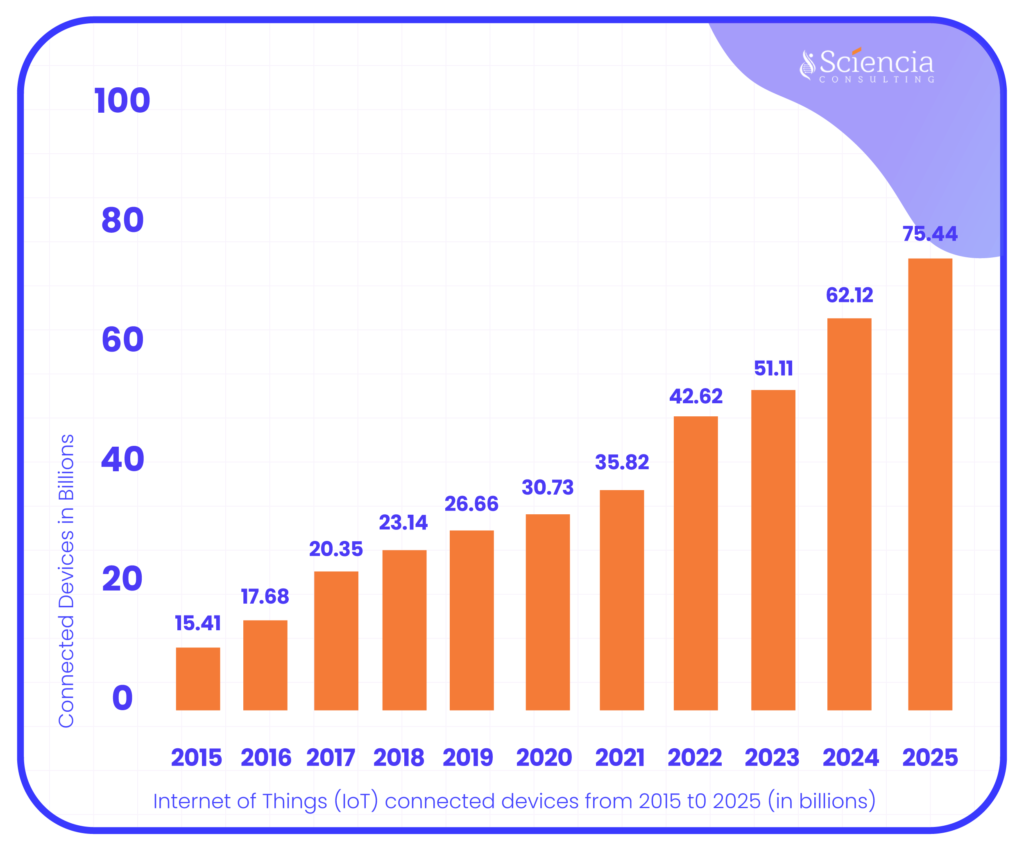
- 2025 will bring 216 million virtual reality users and 2 billion gamers.
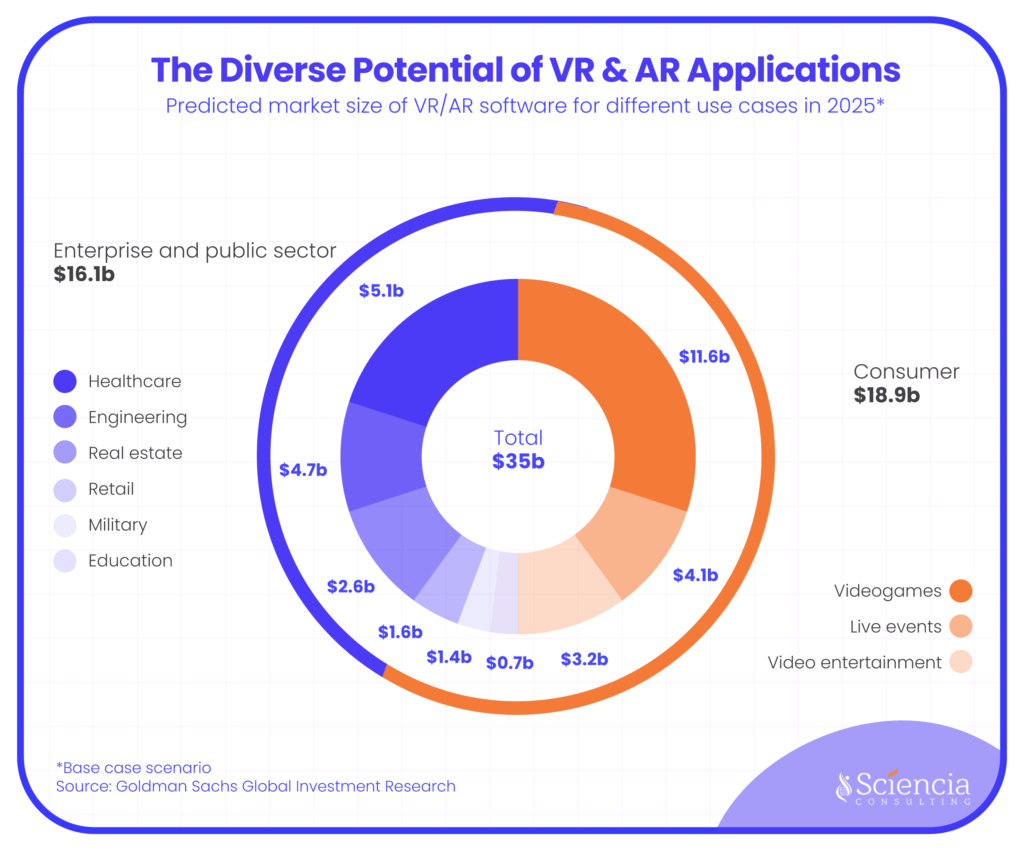
- 75 percent of business professionals believe that blockchain technology will change the way business is done in the future.
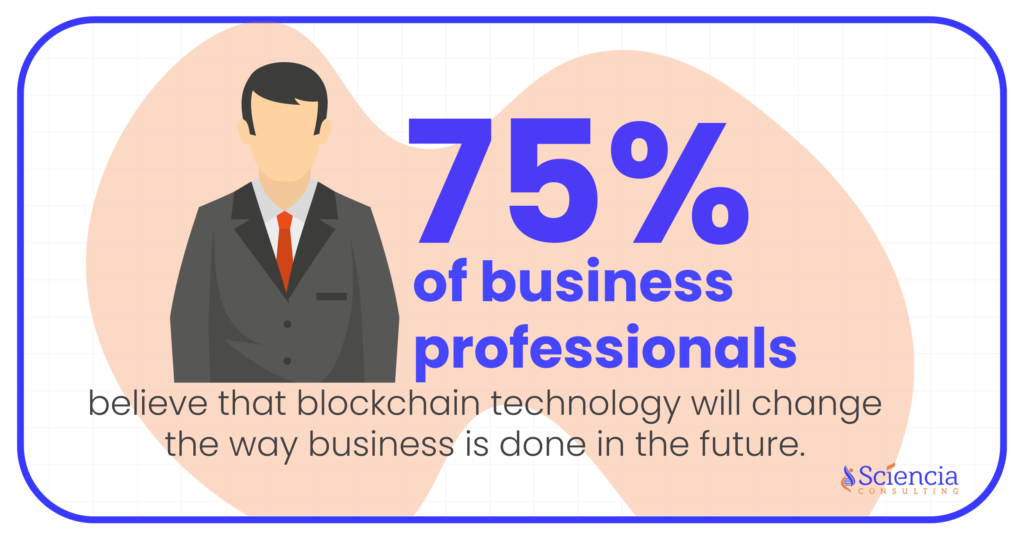
- In 2022, the global Metaverse market size is expected to rise to $47.48 billion US dollars.
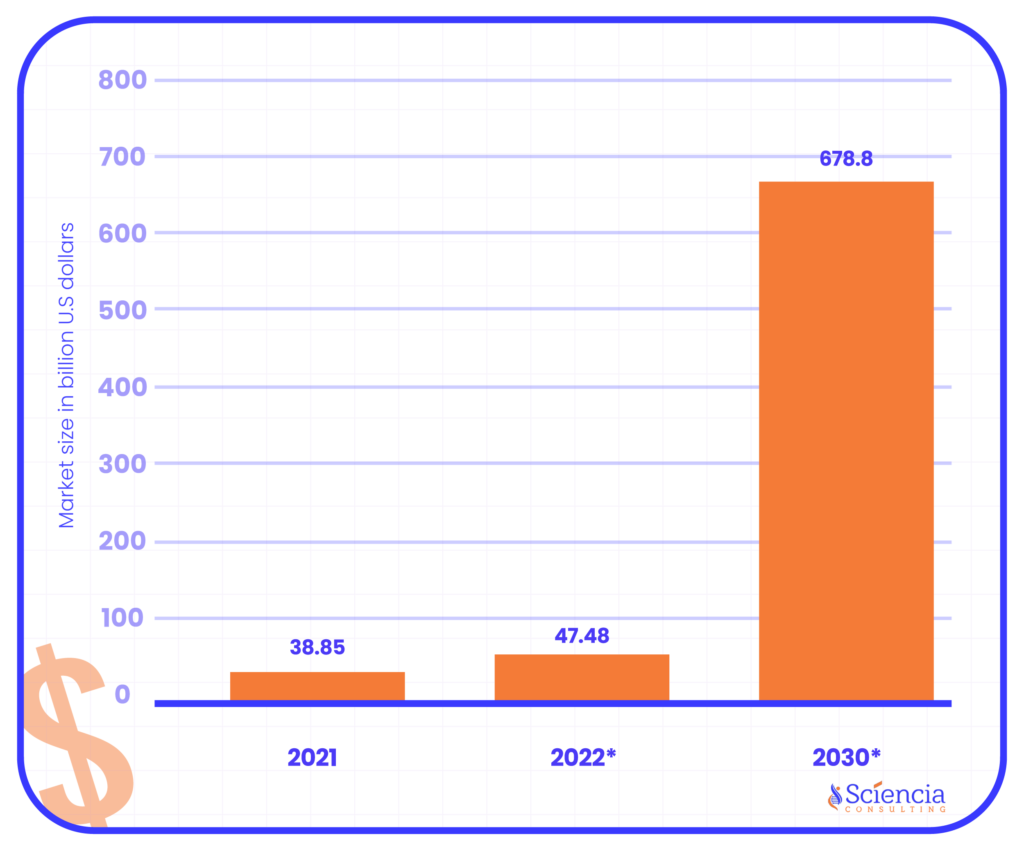
- In 2022, video will account for 82% of all internet traffic.
- 11 different types of jobs will exist in the Metaverse by 2030.
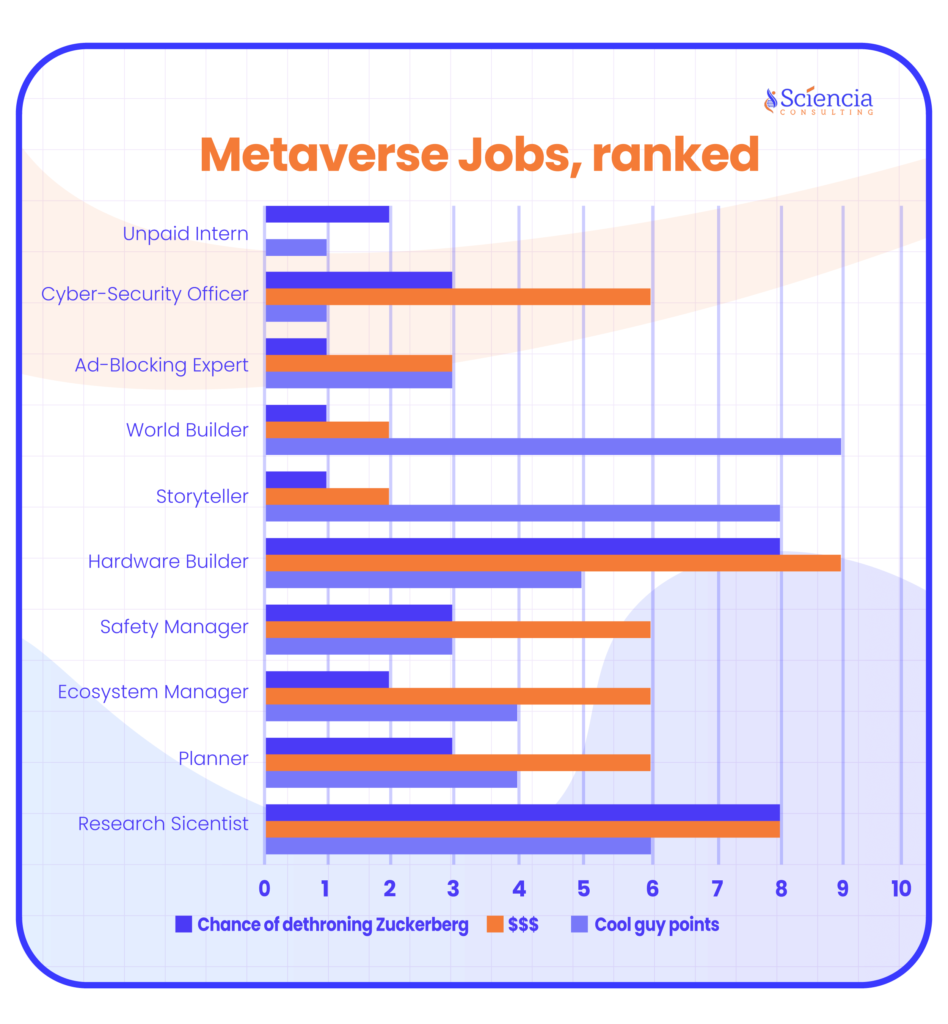
- 56 percent of influencers currently participate in the Metaverse.
- According to The Pew Research Center, technology innovators have predicted that by 2035 a large-scale educational ecosystem will emerge to meet people’s formal and informal learning needs and it will be buttressed with a similarly impressive credentialing and testing regime to give people and employers feedback on those participating in the system.
- More than 160 companies are building the Metaverse right now. The 10 major players include: Tencent Holdings Ltd. (China), NVIDIA Corporation (U.S.), Meta (Facebook Inc.) (U.S.), Roblox Corporation (U.S.), Microsoft Corporation (U.S.), Globant (Luxembourg), Queppelin (India), Alibaba Cloud (U.S.), Netease Inc. (China), Magic Leap, Inc. (U.S.)
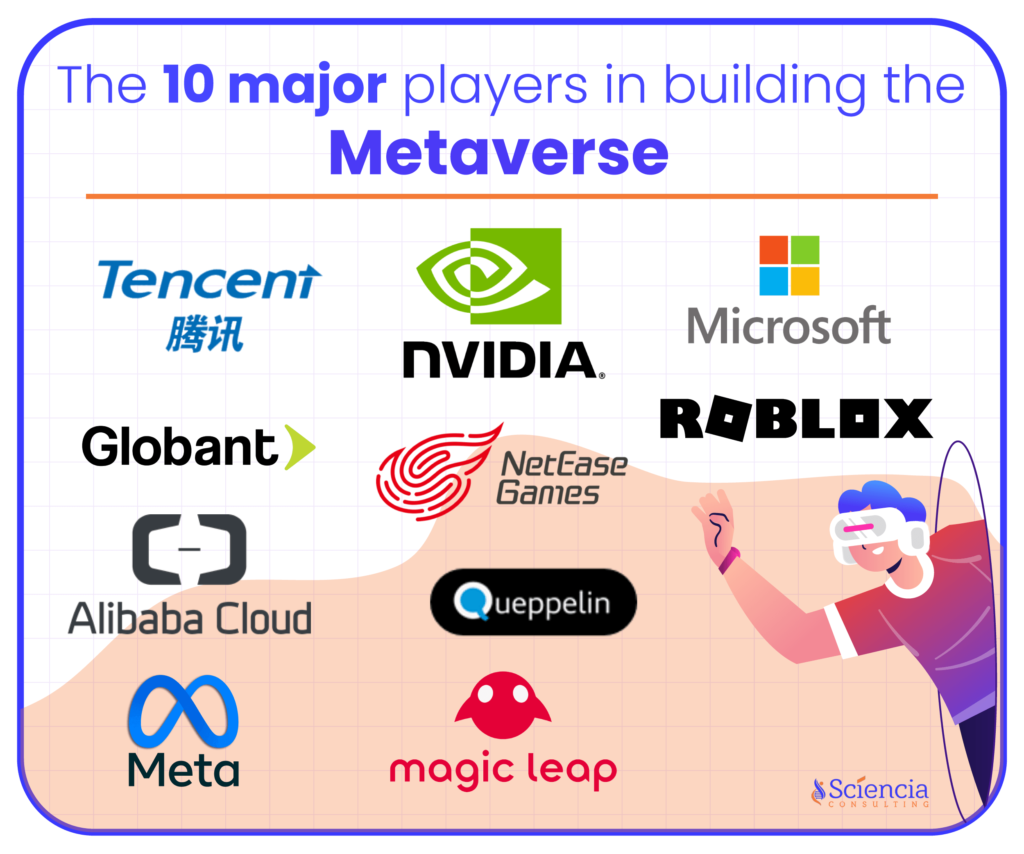
- eSports has grown so popular that it’s now a billion-dollar industry estimated to reach a value of 2.89 billion by 2025.
- $10bn (£7.4bn) is the amount Meta (formerly Facebook) intends to spend to develop virtual reality software and hardware.
- Although coming strong, Metaverse is still a mystery for many people, with only 38% of adults in the United States saying that they heard about the project.
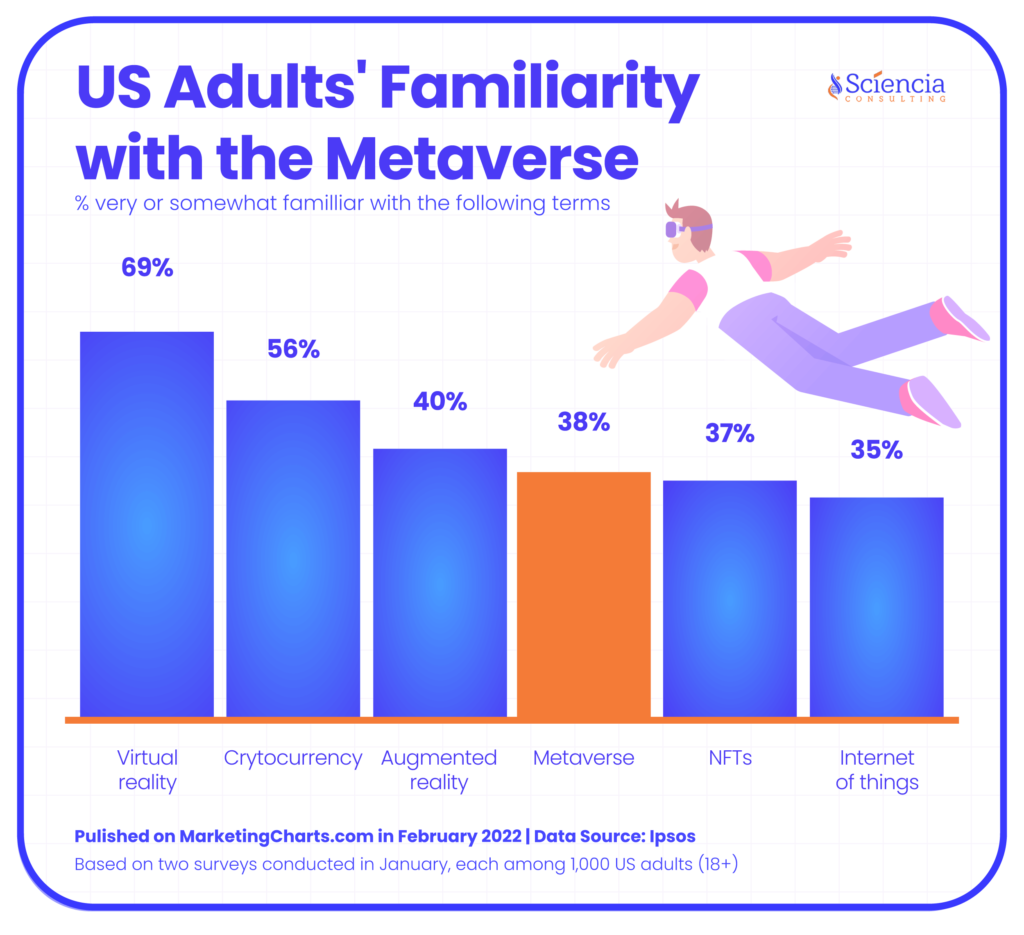
- 67% of agencies want to see more AR and VR in digital advertising campaigns.
- The global augmented and virtual reality market size was valued at USD 21.83 billion in 2021 and is expected to expand at a compound annual growth rate (CAGR) of 15.0% from 2022 to 2030.
- Melanie Subin, director at The Future Today Institute in New York City, predicts that by 2030, “a large proportion of people will be in the Metaverse in some way”.
- “Metaverse” was mentioned 84,000 times on social media in 2021.
- According to Gardner, 2022 will be shaped by 5 impactful technologies, and the Metaverse is one of them.
- Wanna buy land in the Metaverse? Prepare to use NFTs and be mindful that in 2021, the Metaverse Group bought an estate in Decentraland for 618,000 MANA, which was equivalent to about $3.2 million at the time.
- NFTs are a key concept in the Metaverse system. And according to the Global News Wire, the global NFT market size is expected to grow from USD 3.0 billion in 2022 to USD 13.6 billion by 2027, at a Compound Annual Growth Rate (CAGR) of 35.0% from 2022 to 2027.
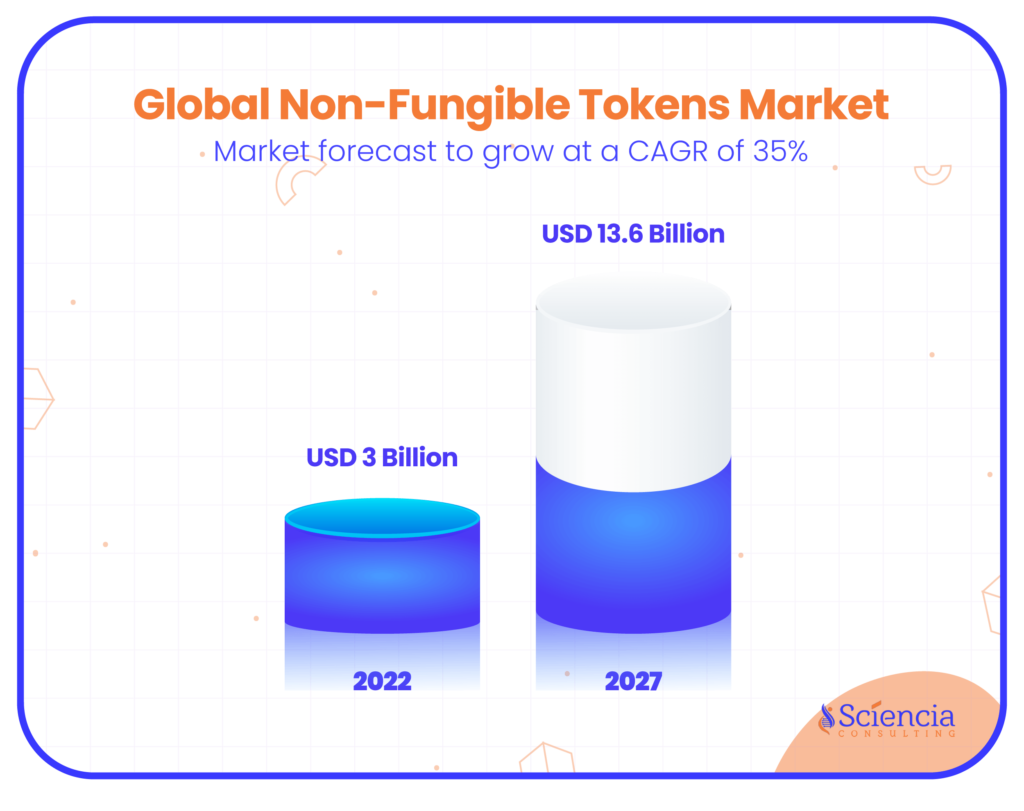
Facebook plans to hire 10,000 people in the EU to build the Metaverse.
What These Numbers Mean To Life Sciences Brands
How Vast Is The Metaverse?
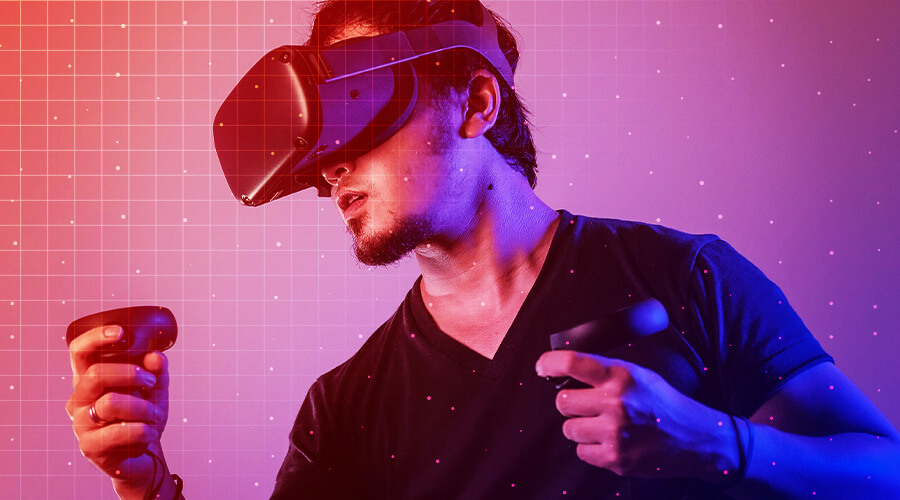
Metaverse statistics show that the VR industry is growing at a very rapid pace. In 2016, there were only about 2 million VR headsets in use. By 2021, the industry grew to nearly 102 million VR headsets. These numbers indicate that more and more consumers are buying VR headsets, and therefore, more are spending time in the Metaverse.
It is estimated that the average person spends about 3 hours per day in the Virtual World (online) versus 7 hours per day in the physical world.
The emergence of cloud applications, social networking, and the expansion of mobile devices has increased the amount of data being exchanged and, consequently, the size of the Metaverse. And it’s not stopping there.
Data exchange is projected to double every two years, which means that the size of the Virtual World will also double every two years. To help you get a visual idea of just how vast the online world is predicted to become, in 20 years it is estimated that the Metaverse will be 1000 times the size of the earth.
Several factors have contributed to this growth:
1) The amount of information being exchanged daily basis has been increasing at an alarming rate
2) The number of people accessing this information has been increasing
3) The number of devices that people use to access this information has been increasing as well
The growth of Virtual Worlds has also been facilitated by technological advances in computer hardware and software (e.g., faster processors) as well as improvements in networking technologies (e.g., Ethernet).
The Metaverse is not only vast, it is also dynamic. It is constantly changing, and the changes are often unpredictable. It’s not just a place where people go to play games or socialize with friends. It is also a place where people can go to learn, conduct business, and even meet new people.
What Does The Number Of People Using Virtual Reality Tell Us?
171 million people worldwide are using VR in some form today. And while the VR industry is still in its infancy, the numbers are clear: VR adoption is growing rapidly, and marketers in all industries need to start experimenting with VR sooner rather than later.
As the technology gets better and cheaper, we will see an even greater increase in adoption. In the meantime, marketers should start experimenting with VR now because it is a great way to create a more meaningful connection with customers and prospects.
When it comes to life science brands, the stakes are even higher. And because the Metaverse statistics don’t lie — the time for life science brands to embrace VR and prepare to enter the Metaverse is now.
How To Get Started
- Create 360-degree videos of your products and services.
- Make 3D models of your products and allow prospects to interact with them in virtual reality.
- Create virtual reality demos that allow prospects to try out your product without having to travel or schedule a meeting at your office.
- Use VR in presentations and pitches instead of PowerPoint slides or video demos.
- Create virtual reality simulations that allow prospects to experience what it would be like to be in a life-threatening medical situation and how your product would help solve their problem.
- Create a virtual reality game that allows prospects to interact with your product before, during, and after use.
- Use VR for employee training and development — especially for recruits or employees who are going to interact with customers directly. This will give them a chance to get familiar with the company culture and products before they meet customers, and it will also help them learn more about the products so they can answer customer questions more knowledgeably.
- Use VR as an educational tool for patients who have trouble physically getting to your office or hospital – this is especially useful for children or people who live in rural areas where travel is difficult. You could also use it as a way of providing remote patient care if you’re dealing with patients in developing countries or emergencies where there aren’t many doctors available to treat patients quickly.
Digital Wallets In The Metaverse Or How Shopping Will Look In The Future
By 2026, the mobile wallet market is anticipated to reach $80 billion, with 66% of individuals confirming that they make mobile wallet payments regularly because it is more convenient than other modes.
Digital wallets are a safe way to store your money, but they will become even more crucial in the future when we have fully implemented AI and machine learning, and when most businesses will also be present in the Metaverse space.
AI is already being used to fight fraud, improve marketing, and analyze data, but in the future, it will be used to decide what you can and cannot buy. This might sound scary, but it is actually a good thing.
AI will be able to determine your risk of buying certain things based on your previous purchases. If you have a history of buying certain products or services, AI will recommend those things to you. For example, if you buy a certain type of mobile phone plan, AI will recommend a specific kind of phone. You don’t have to purchase that specific brand, but you can get that type of device. This will allow AI to determine what products and services you can and cannot buy.
Benefits Of a Metaverse Environment
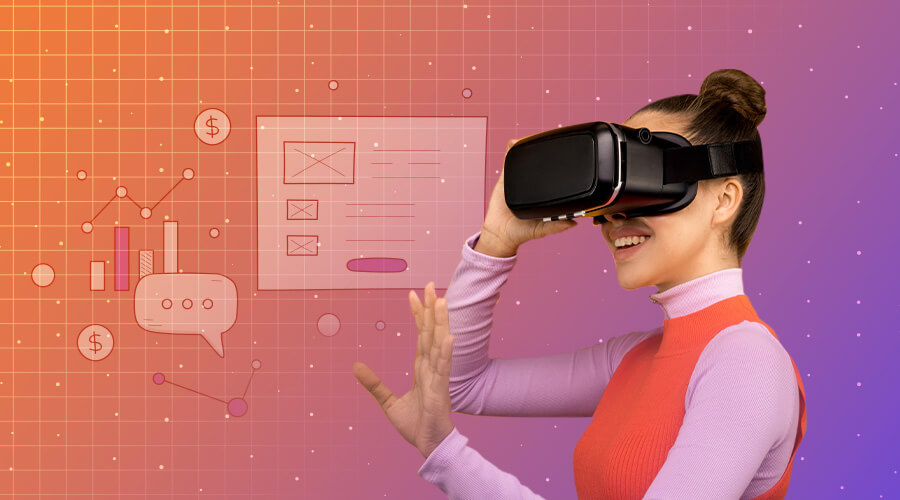
Virtual reality allows you to experience things you wouldn’t be able to otherwise. It offers an opportunity to explore different environments and immerse yourself in new worlds. VR is also a great tool for education. It can be used to inspire curiosity, spark creativity, and allow people to explore new lands and cultures.
Moreover, VR can be a very powerful therapeutic and healing tool. It has been shown to reduce stress, increase social connection, improve empathy, and reduce anxiety.
Additionally—and the following Metaverse statistics should be of great interest for life science brands in particular—the global Virtual Reality (VR) healthcare market is projected to grow from $628.0 million in 2022 to $6.20 billion by 2029, at a CAGR of 38.7%.
VR can be used to treat several different psychiatric conditions, such as autism or Alzheimer’s. Health care brands could use the Metaverse space, for example, to help people with autism practice social skills, such as small talk, public speaking, or meeting new people. These therapies could also be adapted into video games and mobile apps where users could interact with characters that look and respond like real people.
Similarly, virtual reality can be used to help people with Alzheimer’s by immersing them in a familiar environment such as their childhood home. Even more interesting is the use of virtual reality to help people suffering from post-traumatic stress disorder cope with their past trauma.
VR has also been shown to reduce the symptoms of epilepsy and can be used to help people with this condition practice healthy lifestyle habits such as avoiding situations that may provoke seizures, keeping a healthy diet, and regular exercise.
Marketers in the life sciences can use VR for drug discovery, testing, and even therapy. For example, VR can be used to test potential drug candidates for potential toxicity, as well as to show the effectiveness of a new medication in a way that doesn’t involve animal testing.
Further, VR can be used for both patient education and therapeutic purposes. In particular, VR can be used to help people with conditions such as PTSD learn about the disease and how it affects them on an emotional level. While many people think that virtual reality is only useful when it’s used in gaming applications or watching films, there are many other uses for it. The Metaverse statistics we’ve discussed so far prove just that.
Why Life Sciences Should Consider Entering The Metaverse
In the past few years, life science brands have been forced to adapt to a rapidly changing digital environment. As a result, many have turned to social media and other digital platforms to reach consumers. However, while this is an effective way of reaching consumers, it is not the most efficient way of doing so. Other forms of digital marketing have become more cost-effective and time-efficient than traditional marketing methods, making them more appealing to brands that want to reach their target audience.
When it comes to why brands, including life science ones, should consider entering the Metaverse, the main reason is that Virtual reality (VR) and augmented reality (AR) are hot technology trends with the potential to transform how people interact with products and services.
These technologies allow brands to deliver engaging, immersive experiences that leverage the power of immersive technology. When using them, customers can feel as if they’re interacting directly with the brand. They can also get a better sense of how the product or service looks and feels.
On the other hand, AR could allow customers to try on virtual products in their own homes. This could be especially useful for those unable to physically visit stores or make trips to brick-and-mortar stores.
Moreover, VR and AR can help brands promote products in new ways by allowing them to tailor content for individual audiences.
Some brands in the healthcare field have already taken the plunge. For example, GlaxoSmithKline has joined forces with Birmingham City University for a two-year Knowledge Transfer Partnership (KTP) that’ll explore how Augmented Reality (AR) can improve real-world healthcare. GSK is also using AR to help retailers visualize marketing strategies and Point-of-Sale materials.
But for life science companies to be able to use VR and AR as an effective form of advertising and selling, they need to make sure that the content that they create is engaging and realistic. This can be done by hiring a digital marketing agency (hey, that’s us!) that specializes in the life sciences industry and partnering with a software development company that has the capability to create VR and AR experiences.
Different Ways To Enter The Metaverse
1. Build a 3D environment of your own in Second Life, which could be used to showcase your products or services.
2. Create a virtual reality experience that users can interact with and contribute content.
3. Collaborate with other life science brands in the Metaverse to share expertise or knowledge. This could include sharing data or resources such as publications and patents.
4. Work together with advertisers to create virtual environments where users can interact with and engage with marketing messages.
Metaverse FAQs
When was the Metaverse launched?
Metaverse was launched in 2017.
What are the benefits of the Metaverse tokens?
MET is a virtual currency that can be used to purchase assets and goods in the virtual ecosystem. It can also be used to buy products and services offered by Metaverse partners.
Where can I get Metaverse Tokens?
You can get ETP tokens from the following exchanges: Binance, OKEx, and Huobi.
What are the main features of Metaverse?
The main features of the Metaverse platform include its three-dimensional infrastructure, asset profiling system, and blockchain-based identity system.
Where can I find the most up-to-date information on the Metaverse network?
You can find up-to-date information on the Metaverse network at www.mvs.org.
Can you make money with Metaverse?
The value of Metaverse’s token has increased significantly since the company’s ICO, and it is expected to increase even further as the project matures. If you are interested in investing in Metaverse, then it is important to keep track of the company’s progress and news. You can purchase MET tokens from most cryptocurrency exchanges.
Is the Metaverse a fad?
The Metaverse is far from being a fad. VR and AR have been around for decades. But recently, both technologies have become cheaper and more accessible for consumers. This trend has coincided with the rise of social media, which has made immersive technology a more desirable way to communicate. As a result, the virtual reality market is expected to grow and expand more rapidly in the coming years.
What can you do in the Metaverse?
The Metaverse is a place where people from all over the world can meet, talk, and have a good time together. In the Metaverse, you can shop for just about anything. You can buy clothes, cars, homes, or even virtual land and real estate. There are also many events happening in the Metaverse like virtual concerts, where people can attend and make online friends. And lastly, you can create your own content in the Metaverse, like your own blog, profile, or business.
Is Metaverse the same thing as gaming?
Metaverse is more than gaming. VR can be used to train people in empathy, as well as inspire it. It lets you walk in somebody else’s shoes, and experience what it’s like to be them. VR can be a transformative and healing tool. What if there were a way for people to visit the Holocaust Museum in VR, and actually walk in the shoes of those who were imprisoned there? Or visit communities that they may have otherwise avoided because of their differences?
VR can also be used to treat disorders like depression or anxiety, and to help people in need. It can be used to learn about other cultures and explore faraway lands. It can be used to connect people and strengthen communities. The possibilities are endless.
Final Thoughts
Although the life science industry has been typically 5 years behind other industries in terms of digital innovations, history should not repeat itself when it comes to taking advantage of the immense benefits the Metaverse will bring.
We have seen a change after COVID that ramped up the industry’s adoption of technology. We are seeing it occur in life science product development, where you have a diverse group of engineers and scientists working together to bring healthcare innovations to market faster and better. We’ll also need to take this approach to marketing and keep up the pace and stay relevant.
VR has immense potential for applications in life science research, from virtual cell cultures to remote fieldwork. With VR, researchers can manipulate and observe 3D data sets, model new hypotheses, and collaborate from across the globe. VR can also be used to improve the patient experience, by helping people learn how to use medical devices or how to deal with pain.
We’re in a very fast-paced world, and we have to keep up. As a marketer in the life sciences field, now is the time to start exploring this all-encompassing VR ecosystem and immerse yourself in a new world of possibilities.
Metaverse and VR have the potential to truly improve the world, and we can’t wait to see what’s coming next. If our article on the most relevant Metaverse statistics has raised your interest, you might also enjoy:



